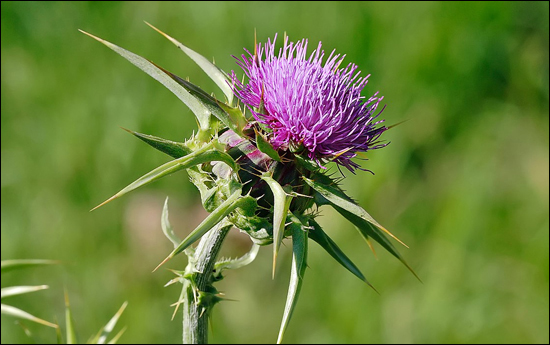Milk Thistle / Silybum marianum / Silymarin – Classification, Ayurvedic Properties & Dosage
Description
Milk thistle, commonly known as silymarin, is a plant named for the white veins on its large prickly leaves. It is native to Mediterranean countries. The fruits and seeds of Milk thistle have been used for liver disorders. It is also called Mary thistle or holy thistle. Milk thistle contains an active component “Silymarin” which is extracted from the seeds of this plant. It has hepatoprotective and antioxidant properties that help in managing liver problems. It is also considered a powerful agent in managing diabetes and its complications. There are several studies conducted on the beneficial role of milk thistle in the treatment of liver disease, diabetes, indigestion, etc.

General Information
It is an erect plant that can grow from 30 to 200 cm tall and it has a conical overall shape. Leaves are lanceolate and 15–60 cm long and usually pinnately lobed, with a prickly edge like more thistles. They are glossy green, hairless and with milky white veins. Flowers are 4-12 cm wide and long, reddish and purplish in colour. Flowering time is from June to August in the Northern hemisphere and December to February in the Southern hemisphere. Fruits are black with long white pappus and they are surrounded by a yellow basal ring.
Synonyms
- Silybum marianum
- Mary Thistle
- Marian Thistle
- Holy Thistle
- Lady’s Thistle
- Saint Mary’s Thistle
- Blessed Milk
Systemic Classification
- Kingdom – Plantae
- Division – Tracheophytes
- Class – Angiosperms
- Order – Asterales
- Family – Asteraceae
- Genus – Silybum
- Species – Marianum
Other Vernacular Names
- Dutch – Vrouwendistel, Mariendistel
- Russian – Ostropestrec
- România – Armurariu
- French – Chardon marie, Chardon argente
- Italy – Cardo mariania
- Spanish – Cardo blano, Cardo mariano
Habitat
It is found in the Mediterranean and most of Europe, south to Central Asia and India. It is probably found in the coast of south-eastern England. Milk thistle has also been widely spread outside its natural range, for example in North America, Australia, Hawaii, Colombia and New Zealand where it is considered an invasive weed. As a result of agriculture it has spread aggressively throughout almost all of Europe.
Cultivation
Milk thistle is an adaptable crop with few needs.It is grown primarily as a medicinal plant, but is also occasionally used as a source of food. It is cultivated mainly in Europe, but is also cultivated in North America and Asia. Milk thistle is a biennial plant, but is usually grown as an annual plant, making it easy to cultivate. When the plant’s main needs are met, it will bloom in the first year.
Chemical Constituents
Milk thistle extract is made from its seeds, which contains Silymarin about 4-6%. Milk thistle extract contains approximately 65–80% of silymarin and 20–35% of fatty acids, consisting of linoleic acid. It is a complex mixture of polyphenolic molecules, consisting of seven flavonolignans that are Silybin A, silybin B, Isosilybin A, Isosilybin B, iso silychristin,silychristin, silydianin and one flavonoid named as taxifolin. Silibinin,A semi-purified fraction of silymarin, primarily a mixture of 2 diastereoisomers, silybin A and silybin B, in approximately a 1:1 ratio.
Mechanism of Action
The hepatoprotective effects of silymarin are achieved through multiple mechanisms, including inhibition of lipid peroxidation, antioxidation and enhanced liver detoxification via inhibition of phase I detoxification and protection against increased glucuronidation and glutathione reduction. It is highly absorbed after oral intake and has a strong first action via the liver.
Therapeutic Properties of Milk Thistle
- Hepatoprotective
- Antioxidant
- Hypocholesterolemic
- Anti-inflammatory
- Antiviral
- Antidiabetic
- Anti-amnesia
- Anti-hypertensive
- Neuroprotective
- Anti-cancer
- Antidote
- Anti-aflatoxin
What Ayurveda has to serve for milk thistle!
Milk thistle is not considered a traditional Ayurvedic herb, as its historical use has been primarily in Western European regions. But from a bioregional Ayurvedic perspective, the practice of working with plants that grow in the local ecosystem, Milk thistle has a lot to offer.
From an Ayurvedic view, Milk thistle has a cooling and cleansing effect on the body. This quality particularly balances the Pitta dosha, although it can also be helpful for both Vata and Kapha.
It is also considered as a Rasayan (Rejuvenating) maily for the liver. It also helps in flushing out the (Ama) accumulated toxins from the body due to its cleansing properties.
Benefits of Milk Thistle
- For Liver Health – The primary and most well-known benefit of milk thistle is its ability to promote liver health. The active component present in milk thistle, is a powerful antioxidant that helps in protecting the liver from damage that is caused by free radicals and toxins.
- For Detoxification – It has antioxidant properties and high concentration of bioactive compounds such as silymarin that has powerful cleansing effects. Thus, it helps in flushing out the toxins from the body.
- For Skin Health – Because of its antioxidant and rejuvenating properties, it helps in skin problems like acne, damaged skin, etc.
- For Weight Loss – Due to its cleansing effects and detoxification action, it helps in weight loss.
Conclusion
Silymarin acts as a potent antioxidant that stabilises cell membranes, regenerates tissues of liver, stimulates the pathways of detoxification, detoxification pathways, inhibits the growth of certain cancer cell lines, has direct cytotoxic activity against select cancer cell lines, and enhances the efficacy of certain chemotherapeutic agents. Its action involves multiple mechanisms that affect the liver and other digestive organs. It has strong preclinical evidence for anticarcinogenic and hepatoprotective activities. However, it has yet to be determined whether milk thistle produces better clinical outcomes.



